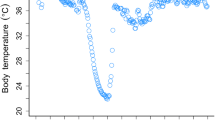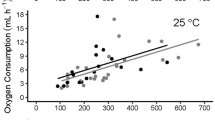Summary
Daily energy metabolism and water flux were measured with doubly labeled water in the free-living insectivorous lizards Cnemidophorus tigris (mean body mass 15.7 g) and Callisaurus draconoides (8.6 g) in June 1979 in the Colorado Desert of California. C. tigris was an active forager; it spent 91% of its 5-h daily activity period in movement. C. draconoides was a sit-and-wait predator; it spent less than 2% of its 10-h activity period in movement. C. tigris had significantly higher rates of field energy metabolism and water influx (210 Jg-1 day-1, 36.8 ul H2O g-1 day-1, N=19) than C. draconoides (136, 17.1, N=18). There were no significant differences between the sexes within either species.
The extra costs of free existence were calculated from differences between field metabolic rates and maintenance costs estimated from laboratory respirometry. Rates of energy metabolism during the field activity period were about 1.5x resting levels at 40° C (∼field active body temperature) for C. draconoides and 3.3 x resting levels at 40° C (∼field active body temperature) for the more active C. tigris. Feeding rates calculated from water influx data were 13.3 mg g-1 day-1 for C. tigris and 5.8 mg g-1 day-1 for C. draconoides. Though C. tigris had a high rate of energy expenditure, its foraging efficiency \(\frac{{{\text{metabolizable energy intake}}}}{{{\text{energy expended}}}}\) was higher than C. draconoides'.
Similar content being viewed by others
References
Alexander GE, Whitford WG (1968) Energy requirements of Uta stans-buriana. Copeia 1968:678–683
Asplund KK (1968) Evolution of body size and habitat selection in whiptail lizards. Ph.D. dissertation. University of California, Los Angeles
Asplund KK (1970) Metabolic scope and body temperatures of whiptail lizards (Cnemidophorus). Herpetologica 26:403–411
Avery RA (1971) Estimates of food consumption by the lizard Lacerta vivipara Jacquin. J Anim Ecol 40:351–365
Avery RA (1978) Activity patterns, thermoregulation and food consumption in two sympatric lizard species (Podarcis muralis and P. sicula) from central Italy. J Anim Ecol 47:143–158
Bennett AF, Nagy KA (1977) Energy expenditure in free-ranging lizards. Ecology 58:697–700
Bennett AF, Gleeson TT (1979) Metabolic expenditure and the cost of foraging in the lizard Cnemidophorus murinus. Copeia 1979:573–577
Bennett AF, Gorman GC (1979) Population density and energetics of lizards on a tropical island. Oecologia (Berl) 42:339–353
Carpenter FL, MacMillen RE (1976) Energetic cost of feeding territories in an Hawaiian Honeycreeper. Oecologia (Berl) 26:213–223
Congdon JD, King NW, Nagy KA (1978) Validation of the HTO-18 method for determination of CO2 production of lizards (genus Sceloporus). Copeia 1978:360–362
DeBenedictus PA, Gill FB, Hainsworth FR, Pyke P, Wolf LL (1978) Optimal meal size in hummingbirds. Amer Naturalist 112:301–316
Dutton RH, Fitzpatrick LC, Hughes JL (1975) Energetics of the rusty lizard Sceloporus olivaceus. Ecology 56:1378–1387
Edney EB (1977) Water balance in land arthropods. Springer Berlin Heidelberg New York
Harwood RII (1979) The effect of temperature on the digestive efficiency of three species of lizards, Cnemidophorus tigris, Gerrhonotus multicarinatus, and Sceloporus occidentalis. Comp Biochem Physiol 3A:417–433
Heinrich B (1972) Energetics of temperature regulation and foraging in a bumblebee, Bombus terricola Kirby. J Comp Physiol 77:49–64
Heinrich B (1975) Energetics of pollination. Ann Rev Ecol Syst 5:139–170
King JF (1975) Seasonal allocation of time and energy resources in birds. In: Paynter RA (ed) Avian Avian Energetics Cambridge, Massachusetts, USA:Nuttall Ornithological Club, p 4–70
Kitchell JR, Windell JT (1972) Energy budget for the lizard Anolis carolinensis. Physiol Zool 45:178–188
Licht P, Jones RE (1967) Effects of endogenous prolactin on reproduction and growth in adult males of the lizard Anolis carolinensis. Gen and Comp Endocrin 8:228–244
Lifson N, McClintock R (1966) Theory of use of the turnover rates of body water for measuring energy and material balance. J Theor Biol 12:46–74
McNab BK (1963) A model of the energy budget of a wild mouse. Ecology 44:521–532
Mueller CF (1970) Energy utilization in the lizards Sceloporus graciosus and S. occidentalis. J Herpetology 4:131–134
Nagy KA (1975) Water and energy budgets of free-living animals: measurement using isotopically labeled water. In: Hadley NF (ed), Environmental physiology of desert organisms. Stroudsburg, Pennsylvania: Dowden, Hutchinson, and Ross, Inc. p 227–245
Nagy KA Energy requirements of free-living iguanid lizards. In Press
Norberg RA (1977) An ecological theory on foraging time and energetics and choice of optimal food searching method. J Anim Ecol 46:511–529
Schmidt-Nielsen K (1972) Locomotion energy cost of swimming, flying, and running. Science 177:222–228
Schmidt-Nielsen K (1975) Animal physiology. Cambridge University New York Press
Schoener TW (1971) Theory of feeding strategies. Ann Rev Ecol Syst 2:369–404
Taylor CR (1973) Energy cost of locomotion. In: Comparative physiology: locomotion, respiration, transport, and blood L Bolis, K Schmidt-Nielsen, and SHP Maddrell, (eds), Amsterdam, The Netherlands: North-Holland Publishing Co p 23–42
Tinkle DW, Hadley NF (1975) Lizard reproductive effort: caloric estimates and comments on its evolution. Ecology 56:427–434
Turner FB, Medica PA, Kowalewsky BW (1976) Energy utilization by a desert lizard (Uta standsburiana). In: BE Norton (ed) US/IBP Desert Biome Monograph No. 1 Utah State Univ Press
Vitt LJ, Ohmart RD (1977) Ecology and reproduction of Lower Colorado River lizards: II. Cnemidophorus tigris (Teiidae) with comparisons. Herpetologica 33:223–234
Vleck D (1979) The energy cost of burrowing by the pocket gopher Thomomys bottae. Physiol Zool 52:122–136
Walsberg GE (1978) Brood size and the use of time and energy in the Phainopepla. Ecology 59:147–153
Wilson KT, Lee AK (1974) Energy expenditure of a large lizard. Copeia 1974:338–348
Wood RA, Nagy KA, MacDonald NS, Wakakuwa ST, Beckman RJ, Kaaz H (1975) Determination of oxygen-18 in water contained in biological samples by charged-particle activation. Analytical Chem 47:646–650
Author information
Authors and Affiliations
Rights and permissions
About this article
Cite this article
Anderson, R.A., Karasov, W.H. Contrasts in energy intake and expenditure in sit-and-wait and widely foraging lizards. Oecologia 49, 67–72 (1981). https://doi.org/10.1007/BF00376899
Received:
Issue Date:
DOI: https://doi.org/10.1007/BF00376899




